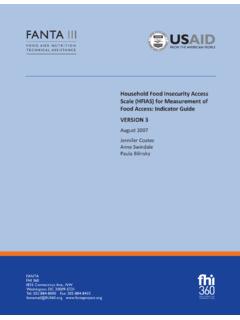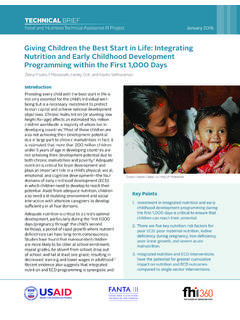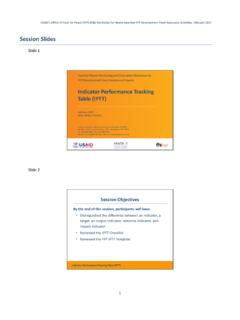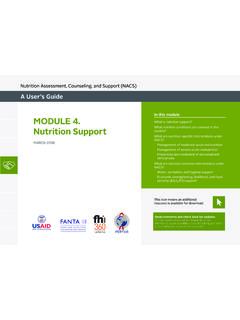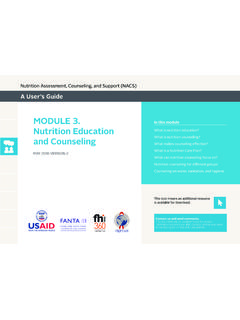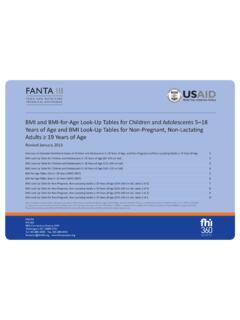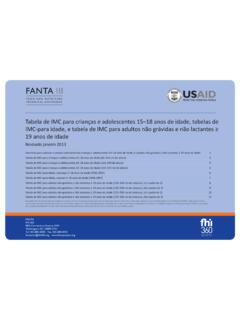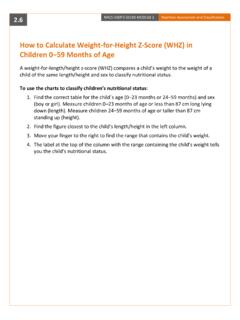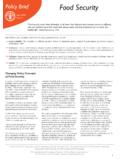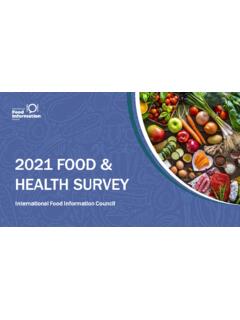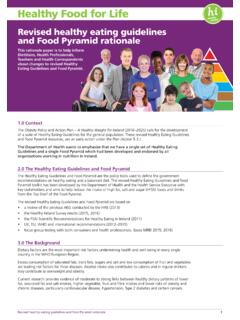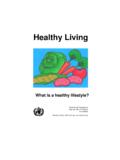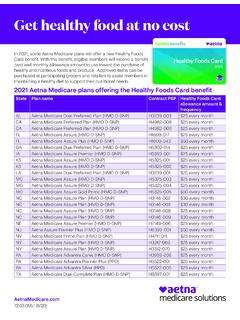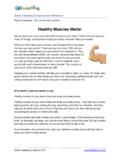Transcription of Why is nutrition assessment important? Nutrition Assessment
1 FANTAIIIFOOD AND NUTRITIONTECHNICAL A SSISTANCEPEPFARN utrition Assessment , Counseling, and Support (NACS)A User s GuideMODULE 2. Nutrition Assessment and ClassificationMAY 2016 VERSION 2In this moduleWhat is Nutrition Assessment ?Why is Nutrition Assessment important? What is Nutrition screening?If health care providers can't assess every client's nutritional status, which clients should they prioritize?How often should Nutrition Assessment be done?What are the different kinds of Nutrition Assessment ? Anthropometric Assessment Biochemical Assessment Clinical Assessment Dietary Assessment food security assessmentThis icon indicates that an additional resource is available for download. Contact us and send document will be updated frequently as new information becomes available. Consider adding your name to our mailing list to receive future updates. 2 Nutrition Assessment and ClassificationIntroductionNACS USER S GUIDE MODULE 2, VERSION 2 What is Nutrition Assessment ?
2 Nutrition Assessment includes taking anthropometric measurements and collecting information about a client s medical history, clinical and biochemical characteristics, dietary practices, current treatment, and food security situation. Why is Nutrition Assessment important? Optimal nutritional status the state of the body with respect to each nutrient and overall body weight and condition is a powerful factor in promoting health and preventing and treating diseases. Weight loss of 10 percent or more has been associated with adverse outcomes and prolonged hospitalization, and in lean, healthy people, weight loss of more than 35 percent has been associated with Nutritional status affects immune response and response to medical therapies. Health care providers assess clients nutritional status for many reasons: yTo identify people at risk of malnutrition for early intervention or referral before they become malnourished yTo identify malnourished clients for treatment malnourished people who are not treated early have longer hospital stays, slower recovery from infection and complications, and higher morbidity and mortality yTo track child growth yTo identify medical complications that affect the body s ability to digest food and utilize nutrients yTo detect practices that can increase the risk of malnutrition and infection yTo inform Nutrition education and counseling yTo establish appropriate Nutrition care plansThe results of a client s Nutrition Assessment and classification of nutritional status determine all the other elements of Nutrition Assessment , counseling, and support (NACS) for that individual including counseling, treatment, and referral to food security and other is Nutrition screening?
3 Full Nutrition Assessment can be preceded by rapid and simple identification of people who may be malnourished or at risk of malnutrition and need more detailed Nutrition Assessment . Nutritionists and trained facility-based health care providers or community service providers can do Nutrition screening in health care facilities, during growth monitoring or home-based care, and during support group meetings. Simple Nutrition screening can include checking for bilateral pitting edema, measuring weight and mid-upper arm circumference (MUAC), and asking about recent illnesses and appetite. Nutrition screening requires standardized training in line with national and local health policy. Special training materials may be needed for low-literacy or illiterate populations. Community service providers need government-approved recording and referral materials, and clear guidance on provider roles, whom to screen, 1 Feldman, M.
4 ; Friedman, L.; and Brandt, L. 2010. Sleisenger and Fordtran s Gastrointestinal and Liver Disease: Pathophysiology, Diagnosis, Management. 9th edition. Philadelphia: Saunders. Chapter 4. Sample Nutrition screening toolsNACS glossary Send a comment or check for new versions 3 Nutrition Assessment and ClassificationOverviewNACS USER S GUIDE MODULE 2, VERSION 2how, and how often. They may also need incentives to do accurate and consistent community Nutrition screening and make health care providers can t assess every client s nutritional status, what clients should they prioritize?1. Children under 2 years of age, especially if they are not breastfed2. Women who are pregnant or up to 6 months postpartum3. People who report unintentional weight loss4. People who have been prescribed specialized food products to treat malnutrition5. People with disease-related symptoms that can be managed through diet6. People with HIV, tuberculosis (TB), or other chronic diseasesHow often should Nutrition Assessment be done?
5 The frequency of Nutrition Assessment depends on a client s age and pregnancy and disease status and on national policies. The recommendations below should be adjusted based on national guidelines. yPregnant/postpartum women: On every antenatal visit yInfants 0 < 6 months of age: At birth and on every scheduled postnatal visit yInfants 6 59 months of age: During monthly growth monitoring sessions for children under 2 and every 3 months for older children yChildren 5 years of age and over: On every clinic visit yAdolescents and adults: On every clinic visit yPeople with HIV: On every clinic visit and when initiating or changing antiretroviral therapy (ART) What are the different types of Nutrition Assessment ? An easy way to remember types of Nutrition Assessment is ABCD: Anthropometric, biochemical, clinical, and dietary. Send a comment or check for new versions 4 Nutrition Assessment and ClassificationAnthropometric AssessmentNACS USER S GUIDE MODULE 2, VERSION 2 Anthropometry is the measurement of the size, weight, and proportions of the body.
6 Common anthropometric measurements include weight, height, MUAC, head circumference, and skinfold. Body mass index (BMI) and weight-for-height are anthropometric measurements presented as indexes. Each of these indexes is recorded as a z-score. Z-scores are measured in standard deviations (SD), and describe how far and in what direction an individual s anthropometric measurement deviates from the measurement for a healthy person of the same age and sex (median). In the bell curve figure, the z-score for the median (middle) measurement is 0. Z-scores lower than the median have minus signs ( , 1). Z-scores higher than the median have plus signs or no signs ( , +2 or 2). Anthropometric Assessment Measurement of z-score compared with the medianOn the number line below, the arrow points in the direction in which the numbers are getting bigger (to the right of the median) or smaller (to the left of the median). The further a measurement is from the median (0) on either side, the greater the risk of malnutrition.
7 Whatever measures are used, the same measures should be used every time a client s nutritional status is assessed in order to compare results. 0 1 2 3 4 5 6-2 -1-3-4-5-6 UndernutritionOvernutrition Send a comment or check for new versions 5 Nutrition Assessment and ClassificationAnthropometric AssessmentNACS USER S GUIDE MODULE 2, VERSION 2 Weight Weighing is usually the first step in anthropometric Assessment and a prerequisite for finding weight-for-height z-score (WHZ) for children and BMI for adults. Weight is strongly correlated with health status. Unintentional weight loss can mean poor health and reduced ability to fight infection. Weighing requires a functional weighing scale that measures weight in kg to within the nearest 100 g. Accurate weight measurement is important because errors can lead to incorrect classification of nutritional status and the wrong care and treatment. Low pre-pregnancy weight and inadequate weight gain during pregnancy are the most significant predictors of intrauterine growth retardation and low birth weight.
8 To reduce the risk of adverse outcomes, women should enter pregnancy with a BMI in the normal weight category. Recommended pre-pregnancy BMI*Pre-pregnancy nutritional statusPre-pregnancy BMIU nderweightLess than or more* BMI is not an accurate indicator of nutritional status during pregnancy; during that period, MUAC should be on how much weight women should gain during pregnancy vary greatly. In 2009, the Institute of Medicine of the National Academy of Sciences published revised gestational weight gain guidelines based on pre-pregnancy BMI ranges recommended by the World Health Organization (WHO). However, the guidelines are based on data from Western countries and have been questioned for their appropriateness across other populations. Research is needed to further refine the recommendations for gestational weight main anthropometric measurement used for newborns is birth weight, which is not a measure of acute malnutrition.
9 Infants with low birth weight (less than 2,500 g) are at higher risk of physical and cognitive impairments and Nutrition -related chronic diseases in later life . All infants lose weight immediately after birth. This is not a problem unless the infant loses 10 percent or more of his or her birth weight. Infants should regain this initial lost weight within 1 week of birth. Most double their birth weight by the end of 5 The most common anthropometric measurements used for infants under 6 months are weight-for-length, weight-for-age, and head circumference. Weight-for-length is used to measure acute malnutrition, along with other clinical signs described later under clinical Assessment . Infants under 6 months should be weighed using a balance beam scale or a digital UNISCALE that measures infant weight by weighing the mother and infant together and subtracting the weight of the mother. 2 Mayo Clinic. 2014. Infant and Child Growth: How much should I expect my baby to grow in the first year?
10 Photo credit: Iain McLellan, FHI 360/FANTAHow to weigh infants and young childrenHow to weigh adults Send a comment or check for new versions 6 Nutrition Assessment and ClassificationAnthropometric AssessmentNACS USER S GUIDE MODULE 2, VERSION 2 Length and heightMeasuring length or height requires a height board or measuring tape marked in centimeters (cm). Measure length for children under 2 years of age or less than 87 cm long. Measure height for children 2 years and older who are more than 87 cm tall and for adults. Weight-for-heightWHZ is an index that is used to assess the nutritional status of children from birth to 59 months of age. It compares a child s weight to the weight of a child of the same length/height and sex in the WHO Child Growth Standards to classify the child s nutritional status. You will need tables with the WHO Child Growth Standards. There are separate WHO Child Growth Standards for boys and girls.
